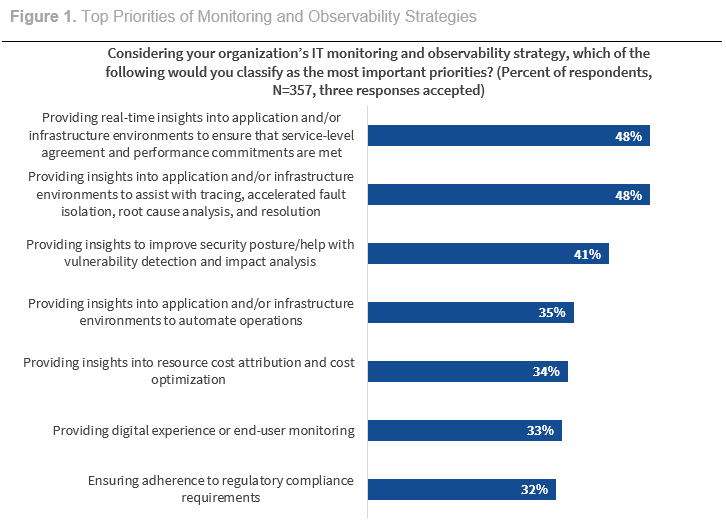By Scott Sinclair, Enterprise Strategy Group Practice Director; and Monya Keane, Senior Research Analyst
Today's businesses are digital, with applications playing a big role in their success. This means they need a new approach to observability—specifically, one encompassing much more than just monitoring application performance. Through innovative health scores, SolarWinds is offering organizations this capability. By connecting observability to particular business use cases and outcomes, SolarWinds offers the appropriate contextualized view to IT and other users to accelerate their digital optimization efforts.
Overview
Today, digital initiatives and the pace of application development are the engines powering business success. Fast, efficient application rollouts drive operational effectiveness, improve customer engagement, and fuel new revenue opportunities through the creation of desirable digital products and services. In fact, 59% of organizations surveyed by TechTarget’s Enterprise Strategy Group now say “data is their business” and some portion of their revenue is generated from digital products and/or services.
[1]
When a business is digital, the experience it provides to its customers often determines its competitive success. The ability to deliver good application performance, respond to any issue quickly, and ensure applications meet or even exceed users’ expectations inside and outside the organization is fundamentally important now.
SolarWinds® Observability could be a beneficial element in any effort to optimize the digital experience organizations present to their customers and internal stakeholders. For example, through its innovative health scores, SolarWinds can connect observability to particular business use cases and outcomes, offering the appropriate contextualized view to IT and other users to accelerate digital optimization efforts.
The Need to Optimize the Digital Experience Is Fueling Observability Adoption
Observability is the practice of equipping software and infrastructure with tools capable of gathering actionable data showing not only when an application error or issue occurs but why it occurred. Most traditional monitoring tools gather information passively; observability practices are different. They focus on actively gathering relevant data, especially factors driving operational decisions and actions.
Today, a clear tie exists between software development and business success. Enterprise Strategy Group recently conducted a study of 357 IT, DevOps, and application development professionals in North America responsible for evaluating, purchasing, managing, and building application infrastructures. All the respondents are currently leveraging or considering leveraging observability practices/solutions. Figure 1 depicts some of the many positive outcomes they hope to see.
[2]

Source: Enterprise Strategy Group, a division of TechTarget, Inc.
In the same research study, Enterprise Strategy Group found 34% of revenue, on average, is directly tied to internally developed or custom applications and a commonly identified benefit resulting from implementing a monitoring/observability strategy is an improved ability to tie IT operations to a business’s key performance indicators (cited by 26% of respondents).
[3]
SolarWinds Observability
SolarWinds Observability is built to provide DevOps and other technical IT teams with an optimal digital experience in monitoring cloud-based apps' performance and resilience. SolarWinds Observability accomplishes this by providing actionable business insights needed to identify and remediate issues. SolarWinds Observability helps companies accelerate and secure their software development environments by doing the following:
- Delivering an optimized experience to users, enabling the organization to more efficiently meet its service-level objectives and improve its mean time to recovery (MTTR), ultimately resulting in better software.
- Spanning multiple locations on- and off-premises. Because modern application environments span multiple locations, robust observability everywhere is a must-have. Without this visibility, observability solutions would be incomplete. Leveraging the ability to span multiple locations, businesses can use SolarWinds to help eliminate monitoring tool sprawl, which is especially valuable since organizations are typically using an average of 12 different tools.[2]
- Enabling DevOps teams to innovate faster through live code profiling by identifying potential user issues or performance bottlenecks before the code is even released. This capability is vitally important, as only 34% of the average developer’s time is spent on net-new innovation.[3]
Businesses must deliver the best digital experience to consumers and their employees to achieve success. SolarWinds Observability helps these organizations accelerate their developers’ velocity, minimize tool sprawl, and achieve better outcomes.
The Bigger Truth
Developers are under tremendous pressure to deliver better code faster. To do this, they need a way to profile code before it goes live to determine how it’s going to perform and what bottlenecks may arise. After the code is live, many different teams (DevOps, SecOps, and IT Ops) need to be able to determine how the application is running.
Many application performance management tools exist, but not all of them are integrated across the widespread environment. They don’t account for the infrastructure, network, and cloud sites. This is the difference between a true observability solution and a typical application performance management tool.
SolarWinds Observability looks at
everything capable of impacting an application—database performance, the network, the application itself, and the infrastructure behind it all—and pulls it all together to correlate a health score offering a single source of truth.
SolarWinds gives constituents a view that will make business sense to them. Everyone works from the same data, not from many disaggregated tools and utilities, and they all get the level of observability they need.
[1] Source: Enterprise Strategy Group Research Report, Data Infrastructure Trends, November 2021.
[2] Source: Enterprise Strategy Group Research Report, Observability from Code to Cloud, May 2022.
[3] Source: Enterprise Strategy Group Complete Survey Results, Distributed Cloud Series: Observability Trends, May 2022.
This Enterprise Strategy Group Showcase was commissioned by SolarWinds and is distributed under license from TechTarget, Inc.
All product names, logos, brands, and trademarks are the property of their respective owners. Information contained in this publication has been obtained by sources TechTarget, Inc. considers to be reliable but is not warranted by TechTarget, Inc. This publication may contain opinions of TechTarget, Inc., which are subject to change. This publication may include forecasts, projections, and other predictive statements that represent TechTarget, Inc.’s assumptions and expectations in light of currently available information. These forecasts are based on industry trends and involve variables and uncertainties. Consequently, TechTarget, Inc. makes no warranty as to the accuracy of specific forecasts, projections or predictive statements contained herein.
About Enterprise Strategy Group
Enterprise Strategy Group is an integrated technology analysis, research, and strategy firm that provides market intelligence, actionable insight, and go-to-market content services to the global IT community.
contact@esg-global.com
www.esg-global.com
© 2023 TechTarget, Inc. All Rights Reserved









